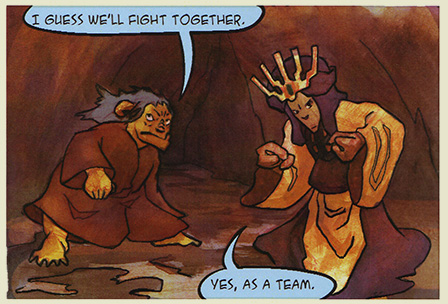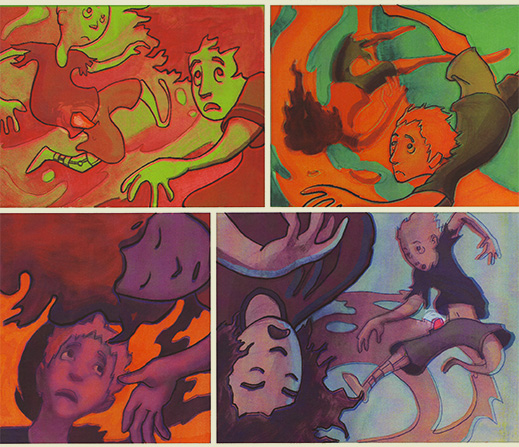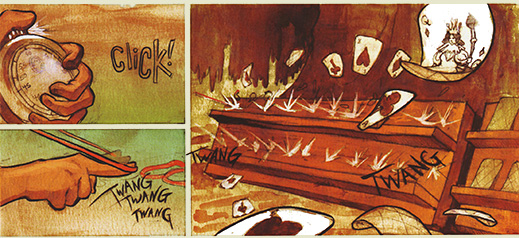Kings of Overgrove
Created by: ArelHerbrand and David Nielsen
Published by: Self-published
Pages: 129



Growing up, my mother walked a tremulous line between protecting me and encouraging me to read widely and broadly. I was voracious for the written word and would often pick up books that were beyond my ability to understand completely. Certainly I was still indulging less literary works, thrillers and Choose-Your-Own-Adventures and Anne McCaffrey. I will always have a soft spot for the easy story, the work that won't push me too hard. Makes nice cushion between the blood-fisted challenges that leave readers exhausted of mind and spirit.
In any case, while I was reading light fantasy novels and three-minute mysteries across the breadth of fourth and fifth grades, I was simultaneously challenging Homer and Dante. My mother saw me reading and loved it and wanted to spur that romance with the humanities. At the same time, being a firm evangelical Christian added to the normal parent's common understanding that some books were too mature, too grown up, too confusing for a ten-year-old kid. 11I remember in 1984 encountering my first of what would become the era's barrage of in-school anti-drug propaganda. It was surreal and filmed with what nostalgia tells me was a kind of mid-'70s low-budge aesthetic. There was heavy emphasis on some shadowy figure offering 'ludes. I had no idea what was going on and had no context with which to interpret the film we were being shown. While I would be offered pot in the succeeding years, I have never encountered anyone who wished to indoctrinate me in the magical ways of disco biscuits. So yeah, I can understand and get behind the idea of introducing young readers to mature works gradually and according to what their minds and experience will allow them to take in. Note that while not really much of a prude in any sense, I likely won't be handing my son Chester 5000 for his tenth birthday. No matter how much he likes robots.
 Shred!!!
Shred!!!
The longshot of this is that in the midst of all the Real books I was reading, my mother also offloaded a lot of lighter fare that was intended to be morally benign to young readers. And morally benign here means that they would have pretty clear moral lessons, the kind that might make Aesop seem a subtle fox. My mother wasn't looking to have me brainwashed, but I think she wanted to take pleasure in my pleasure for stories without having to worry that I would have to concern myself with the corrupting craziness that sits behind simple words. Because words are power and anyone who tells you different is not your friend. In all her gifts of books, there were some gems, some treasures that I'll remember fondly for life. Simultaneously and perhaps more often, there were artifacts of literary detritus. One of the troubles with intentionally rendering a story morally benign is that you also render it morally inert. In making a book harmless, you break its teeth and remove any of its real wonder. I don't care how many unicorns and dragons and wardrobes and heroes and rainbows that bleed more rainbows you inject into your story: if I can't feel like your characters are real enough to make the kinds of mistakes I would make, you're going to have a hard time selling my on your drama.
Thinking about this brings to mind a particular gift I received in 1983. John Bibee's The Magic Bicycle. Despite feeling that I was perhaps too old to be reading a story about a magic beach cruiser, I read on. Because that's what I'd do. I've forgotten nearly every pertinent detail from the story save for 1) that I'm pretty sure this kid discovers his bike can fly, and 2) there's a giant snake with red eyes. And most apropos our discussion here: the book wore its moral on its sleeve. I don't remember the exact lesson, but I remember there being an exact lesson.22Though a quick wiki tussle reveals the book sells as allegory for Christianity. So there you go. For better or worse, allegory has a long and drawn out history in Christian fiction. And as a ten-year-old, that bothered me. I didn't hate the book. I may have even enjoyed it (I think I ended up reading its first sequel as well). But obvious morals have always bothered me.33In the case of The Magic Bicycle, I believe I remember being disappointed in the obviousness of it all and feeling as though I was being talked down to, but simultaneously feeling compassion for the author who clearly put a bit of work into this thing and was probably doing the best he could and maybe he just didn't understand that kids could grok his point even without the telegraphy. I've always had trouble critiquing creators who seem earnest and humble. If a book ended with a lesson that was underscored by characters nudging and winking to make sure I didn't miss them dropping the wisdom on me—well, I was pretty immediately put off.
 A wild moral has appeared.
A wild moral has appeared.
Maybe it was my generation. Maybe it was me. I'm pretty sure that not everyone reacted the same. Glancing at various reviews of The Magic Bicycle reveals that a lot of people thought fondly of it—those that didn't think it was too dark, at any rate. So I want to be careful not to push my experience of Books With Morals as normative. I'm pretty sure it isn't. But it's important groundwork to have laid when I talk about Kings of Overgrove.
Arel Herbrand and David Nielsen have put together a book aimed at a youthful demographic. And most probably at youthful males. I think many of those in that collection of readers will probably enjoy the book (if they haven't already been corrupted by X-Mens and Final Crises and Avengers: Men in Tights). It's a kind of quaint story and, like The Magic Bicycle, wears its moral lesson proudly.44Unlike The Magic Bicycle, it's not any kind of blatant allegory for a metaphysical ideology. At least not so I'd notice. Because of its use of an obvious life lesson, I probably wouldn't have cottoned to it so well when I was safely within its demographic grasp. Now, as I approach middle age, its rather contrived plot and clearcut moral falls a bit flat.
 Take it off, Poot! Take it all off!
Take it off, Poot! Take it all off!
I always have a bit of a struggle knowing how to review a book intended for someone who is not me. If I like it, then great. But if it isn't quite my bag, then is it even fair for me to expect that it might be? I read James Kochalka's lauded Johnny Boo and felt pretty hollow inside. It makes sense, I guess. After all, I'm not five. And I have a hard time remembering what I would have liked when I was that age. I have a better sense of what I would have liked at the age Herbrand and Nielsen are aiming at, but I have little confidence that my tastes as a ten-year-old were at all worthwhile. So then, how to review? I suppose I'll start with what I like.
Kings of Overgrove has an entirely indie aesthetic sense. From its visual sense to its printing to its design, the book is clearly a labour of vision and love. It's all very DIY and prompts the reader to consider that its creators are doing it their way. The spine is blank, making the book a mystery when on the shelf in your library.55I have several such books in my collection and despite the mild annoyance of not having the titles smiling out at me from the shelf, I really do cherish the fact that they exist and what they represent about the creative human spirit. The word balloons feature an obvious stairstepping effect common to low-res lines that don't use anti-aliasing. The colour palettes are all over the place. It's really pretty charming. It would be weird seeing this from a big-name publisher, but when you realize it's the work of just a couple of guys who had a story in them, it's easy to become more enthusiastic.
 1967 is calling and says it's okay if you keep its Monterey Pop Festival.
1967 is calling and says it's okay if you keep its Monterey Pop Festival.
I'm unfamiliar with Nielsen's work and it certainly isn't of a style I've ever seen employed in comics art, but he does a fair job in visual storytelling. It's rare that any panel's purpose is ambiguous or confusing, and he successfully conveys meaning in every instance. His colour choices, while often not to my taste, are boldly planned and do work to maintain the alien nature of the underworld into which the two protagonists venture. Nielsen employs a loose exaggerative form of cartooning that reminds me of some of my dad's splotch people experiments from the '70s.
The writing gets a little dicier for me and is where my adult vision for what a story should be collides with what an eight-year-old would probably be fine with. There's nothing particularly bad about any of it when taken from the perspective of the book's intended audience. Still, for the mature reader (the vantage66Debatable! from which I review), incongruities threaten to tear at one's ability to suspend disbelief. On the second page, the grandfather of the two young protagonists pits the boys in a stopwatch-timed challenge to shoot down twenty-five cards with twenty-five rubber-bands and then is baffled and disappointed by the fight that breaks out at the challenge's conclusion.
 Behold: the sadistic grandfather trials!
Behold: the sadistic grandfather trials!
I wasn't sure exactly what we were supposed to think of the grandfather here. Over the course of the story, he secures the role of wise old patriarch who knows far more than he lets on, but this establishing moment made me kind of just think he was sort of a jerk. In another series of incidents in the book's fantasy setting of Undergrove, the boys have multiple opportunities to end the depravities of the book's villain, Evilharris, once and for all but always demur, letting him go. This is a creature who has murdered countless persons by this point in the story and is intent on their own deaths. That they continually leave him to his own devices seems implausible—especially for Bobbie, who is violent, destructive, and happy to be the victor in any fight. And then of course there are the several overt morals, pet peeves perhaps only for myself.
This is not to say that younger readers will object to any of this. In fact, I'd be happy to recommend it to children around eight years of age who are interested in an in-your-own-backyard fantasy adventure. My own children are still at least five years off from the demographic so I can't really test the theory, but my wife (who's also read it) believes it could be popular with kids in the intended range. This probably would have fallen into the same realm for me as a child as The Magic Bicycle, a fun enough diversion for a summer afternoon. So feel free to check out the book's website for a preview and method for ordering (it's indie enough that you won't find it on Amazon).
Good Ok Bad features reviews of comics, graphic novels, manga, et cetera using a rare and auspicious three-star rating system. Point systems are notoriously fiddly, so here it's been pared down to three simple possibilities:
3 Stars = Good
2 Stars = Ok
1 Star = Bad
I am Seth T. Hahne and these are my reviews.
Browse Reviews By
Other Features
- Best Books of the Year:
- Top 50 of 2024
- Top 50 of 2023
- Top 100 of 2020-22
- Top 75 of 2019
- Top 50 of 2018
- Top 75 of 2017
- Top 75 of 2016
- Top 75 of 2015
- Top 75 of 2014
- Top 35 of 2013
- Top 25 of 2012
- Top 10 of 2011
- Popular Sections:
- All-Time Top 500
- All the Boardgames I've Played
- All the Anime Series I've Seen
- All the Animated Films I've Seen
- Top 75 by Female Creators
- Kids Recommendations
- What I Read: A Reading Log
- Other Features:
- Bookclub Study Guides









